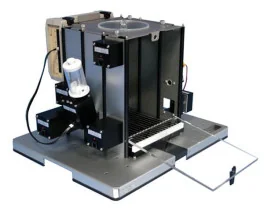Authors
F Michoud, L Sottas, LE Browne, L Asboth, A Latremoliere, M Sakuma, G Courtine, CJ Woolf, SP Lacour
Lab
Ecole Polytechnique Fédérale de Lausanne (EPFL), Geneva, Switzerland
Journal
Journal of Neural Engineering
Abstract
Nerves in the peripheral nervous system (PNS) contain axons with specific motor, somatosensory and autonomic functions. Optogenetics offers an efficient approach to selectively activate axons within the nerve. However, the heterogeneous nature of nerves and their tortuous route through the body create a challenging environment to reliably implant a light delivery interface. Approach. Here, we propose an optical peripheral nerve interfacean optocuff, so that optogenetic modulation of peripheral nerves become possible in freely behaving mice. Main results. Using this optocuff, we demonstrate orderly recruitment of motor units with epineural optical stimulation of genetically targeted sciatic nerve axons, both in anaesthetized and in awake, freely behaving animals. Behavioural experiments and histology show the optocuff does not damage the nerve thus is suitable for long-term experiments. Significance. These results suggest that the soft optocuff might be a straightforward and efficient tool to support more extensive study of the PNS using optogenetics.
BIOSEB Instruments Used:
Dynamic Weight Bearing 2.0 (BIO-DWB-DUAL)

 Douleur - Allodynie/Hyperalgésie Thermique
Douleur - Allodynie/Hyperalgésie Thermique Douleur - Spontanée - Déficit de Posture
Douleur - Spontanée - Déficit de Posture Douleur - Allodynie/Hyperalgésie Mécanique
Douleur - Allodynie/Hyperalgésie Mécanique Apprentissage/Mémoire - Attention - Addiction
Apprentissage/Mémoire - Attention - Addiction Physiologie & Recherche Respiratoire
Physiologie & Recherche Respiratoire
 Douleur
Douleur Métabolisme
Métabolisme Système moteur
Système moteur Neurodégénérescence
Neurodégénérescence Thématiques transversales
Thématiques transversales Système musculaire
Système musculaire Functions de motricité générale
Functions de motricité générale Troubles de l'humeur
Troubles de l'humeur Autres pathologies
Autres pathologies Articulations
Articulations Système Nerveux Central (SNC)
Système Nerveux Central (SNC)  Système sensoriel
Système sensoriel Bioseb on booth #14 at OARSI 2024 in Vienna
Bioseb on booth #14 at OARSI 2024 in Vienna 